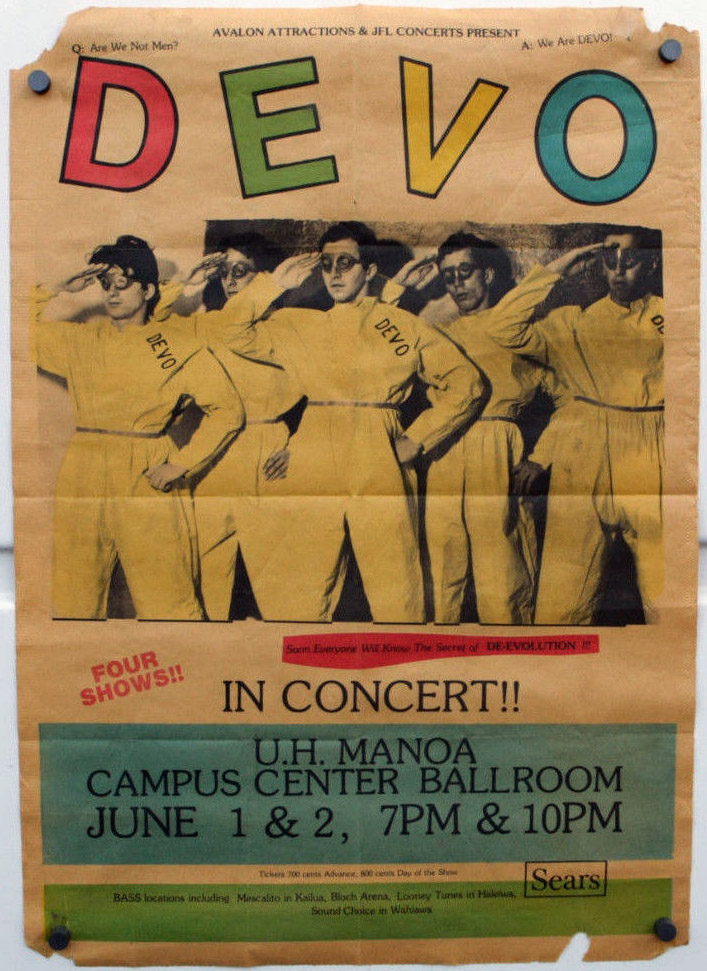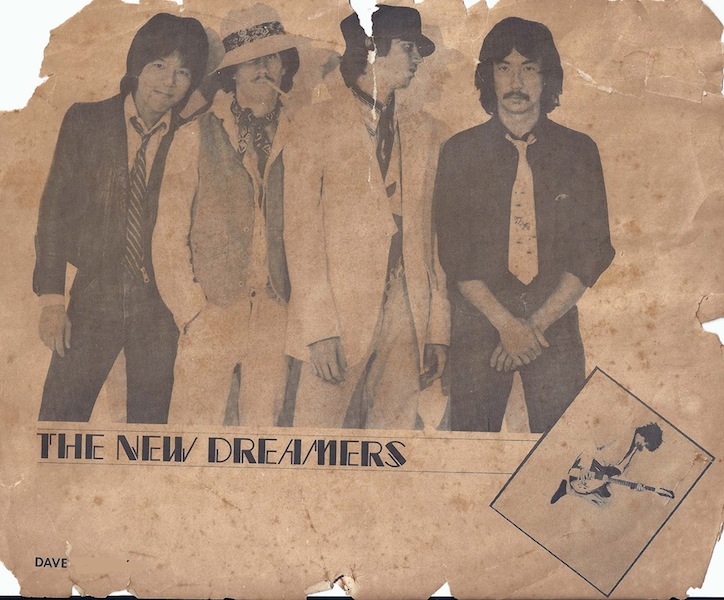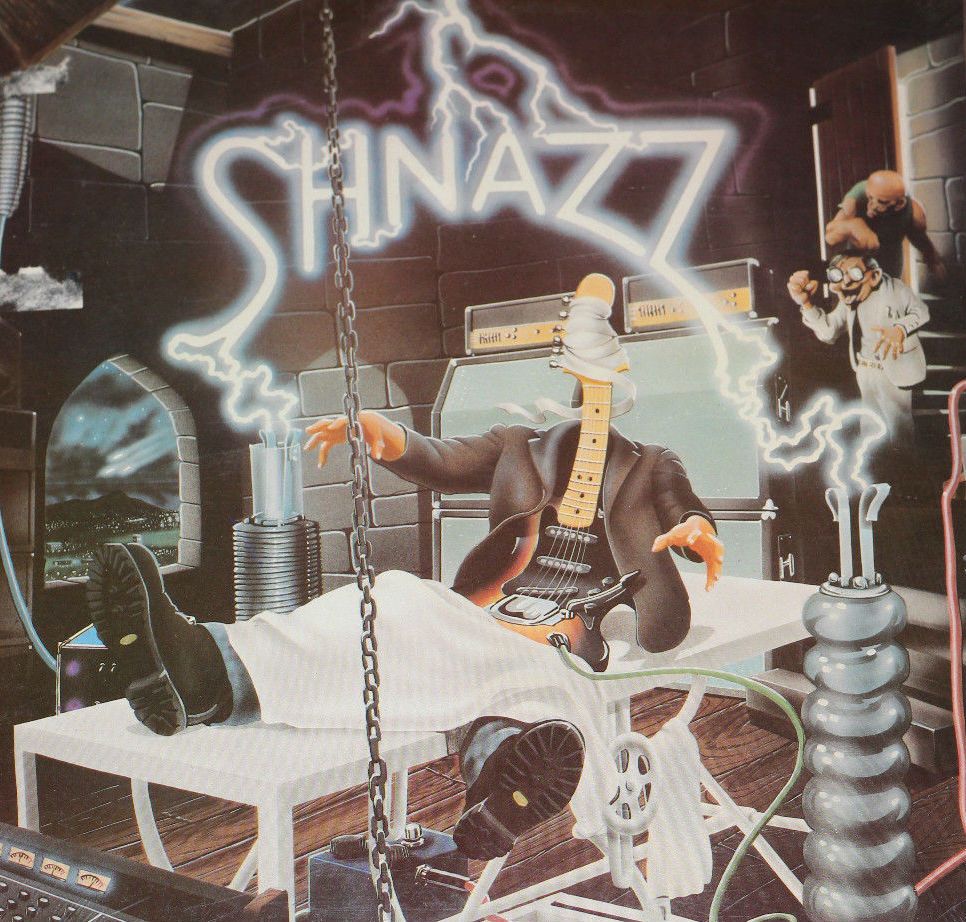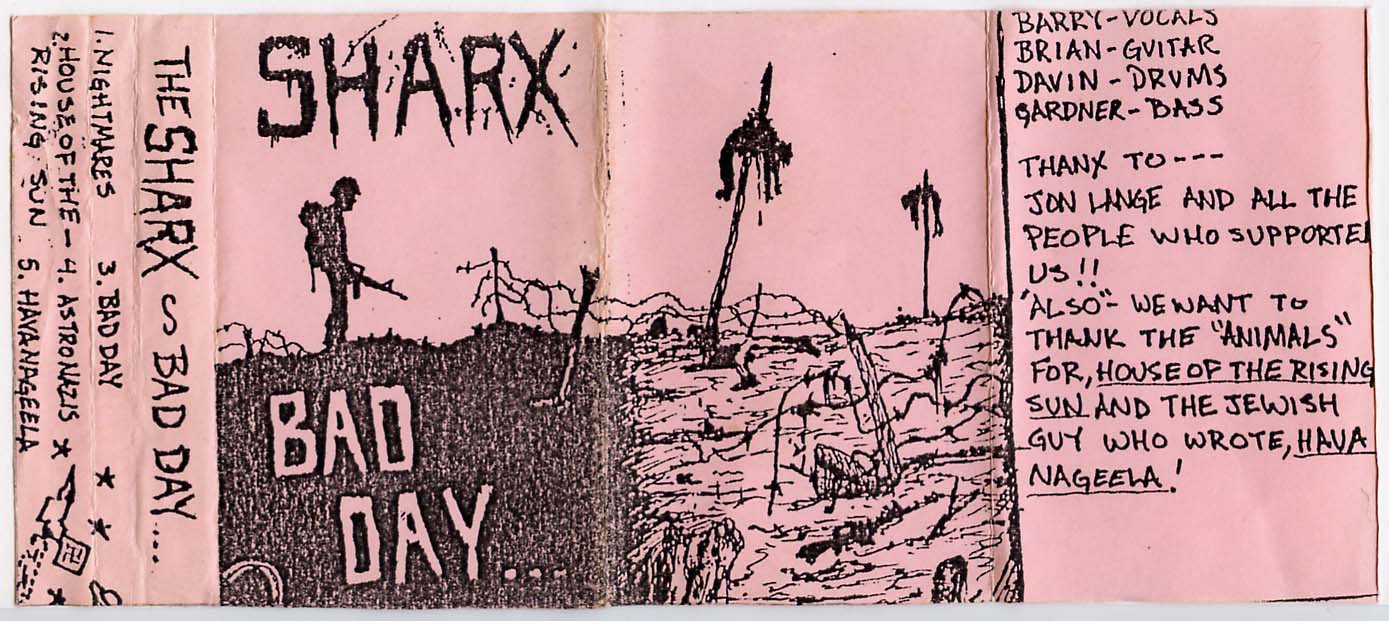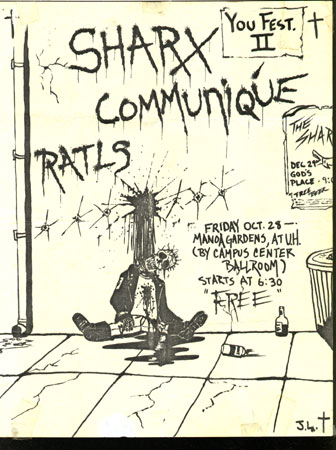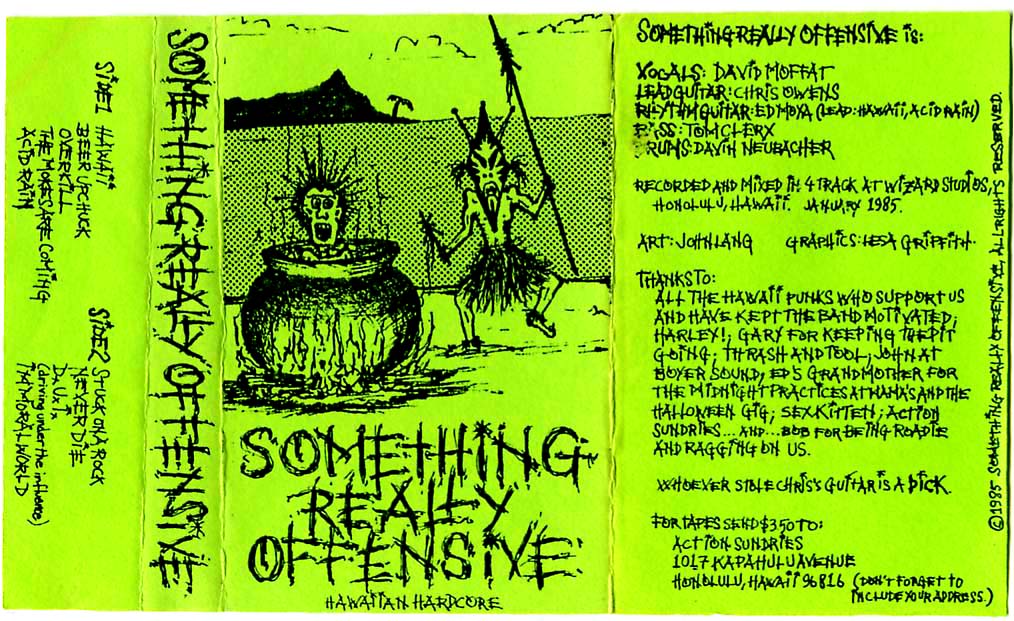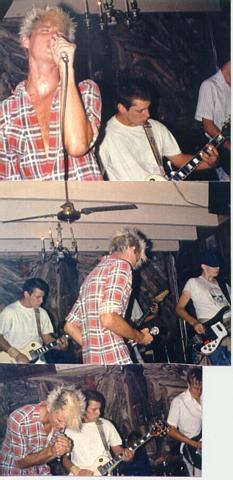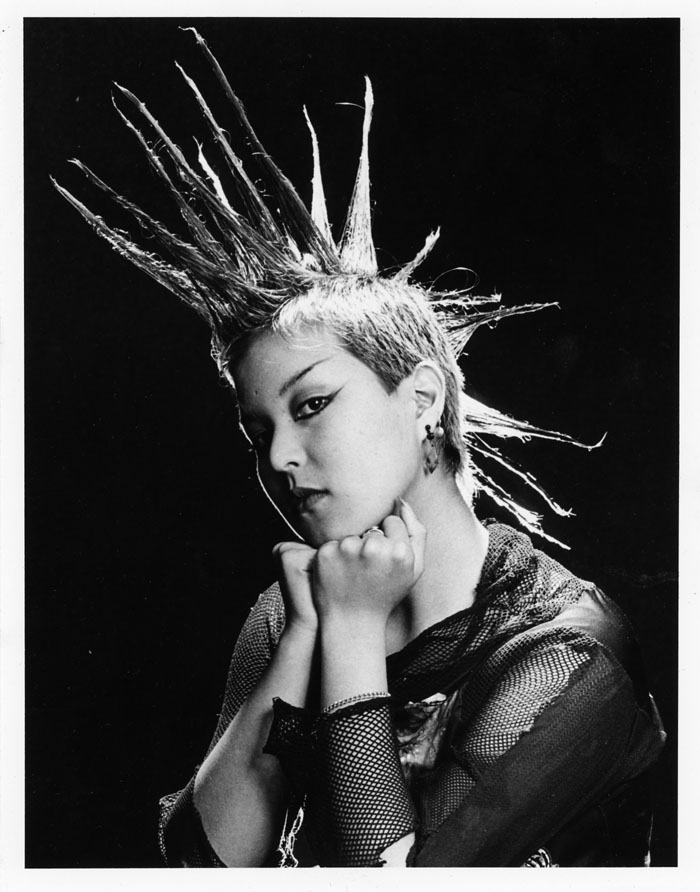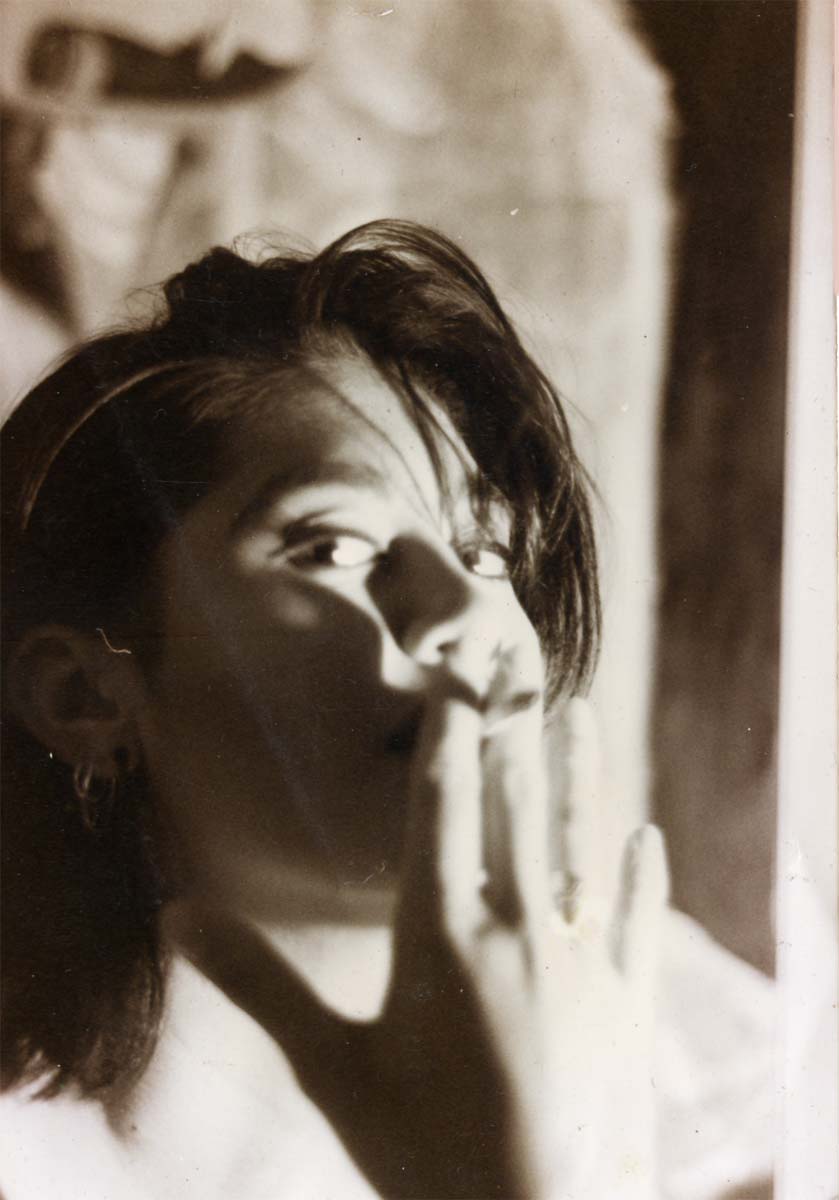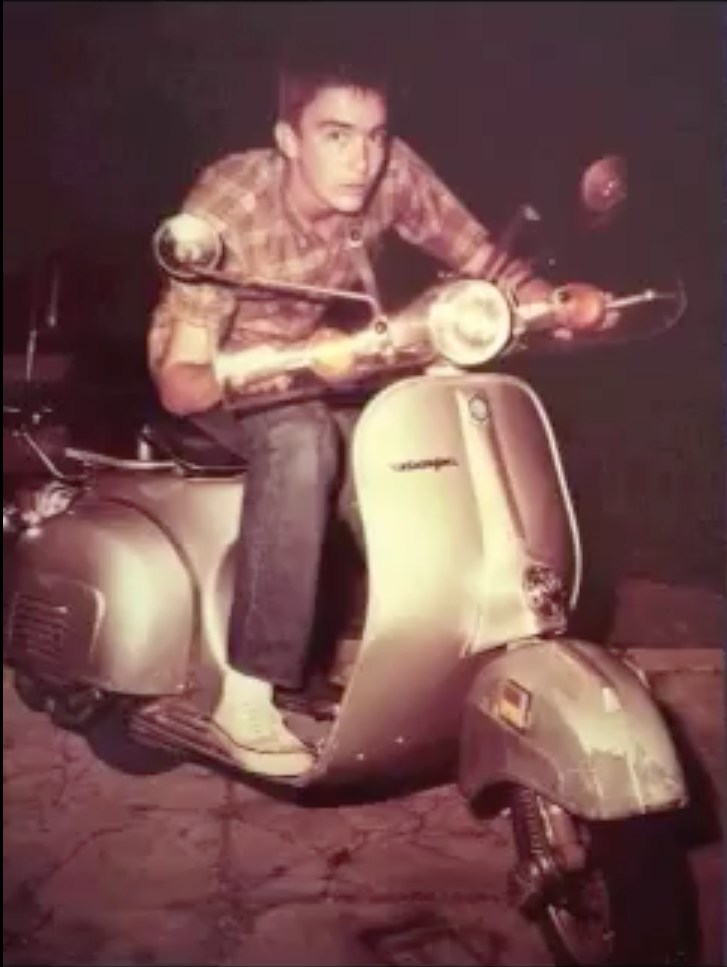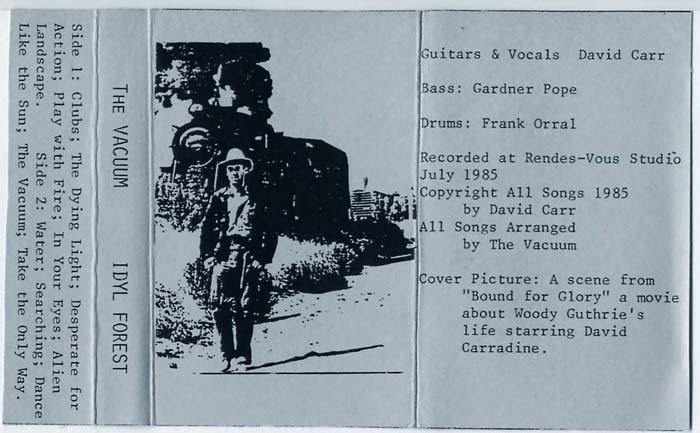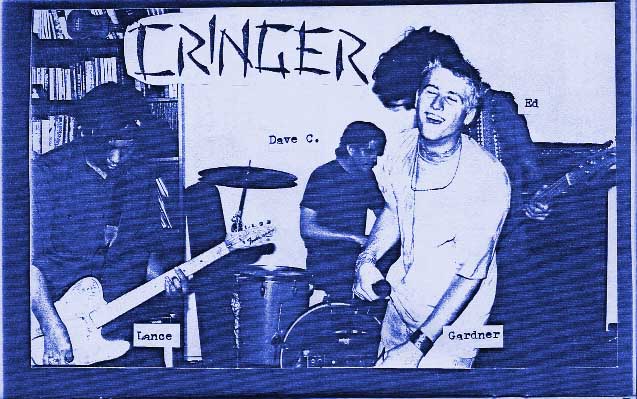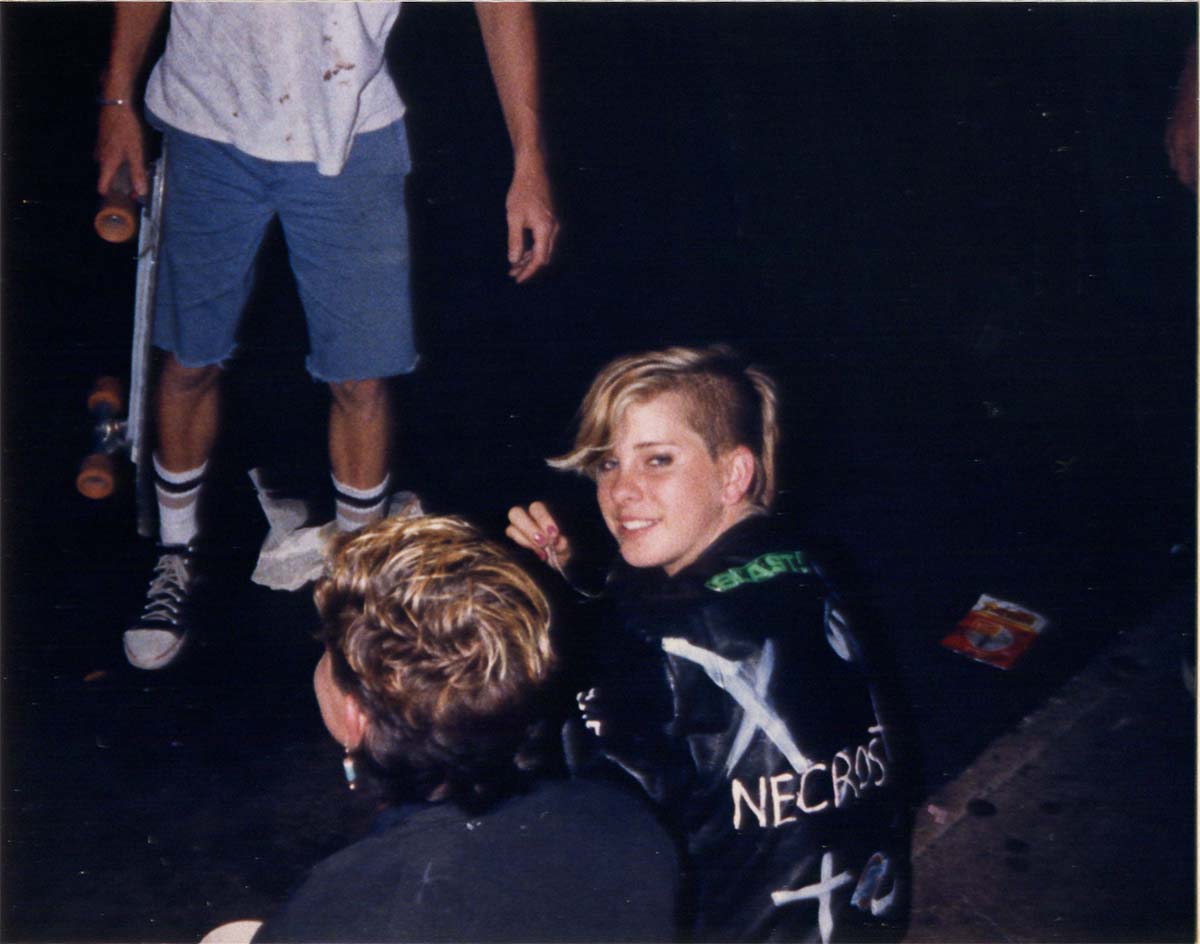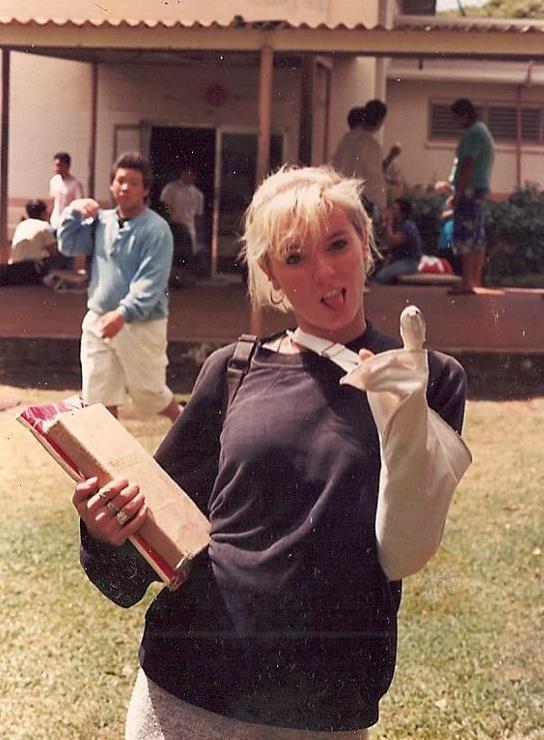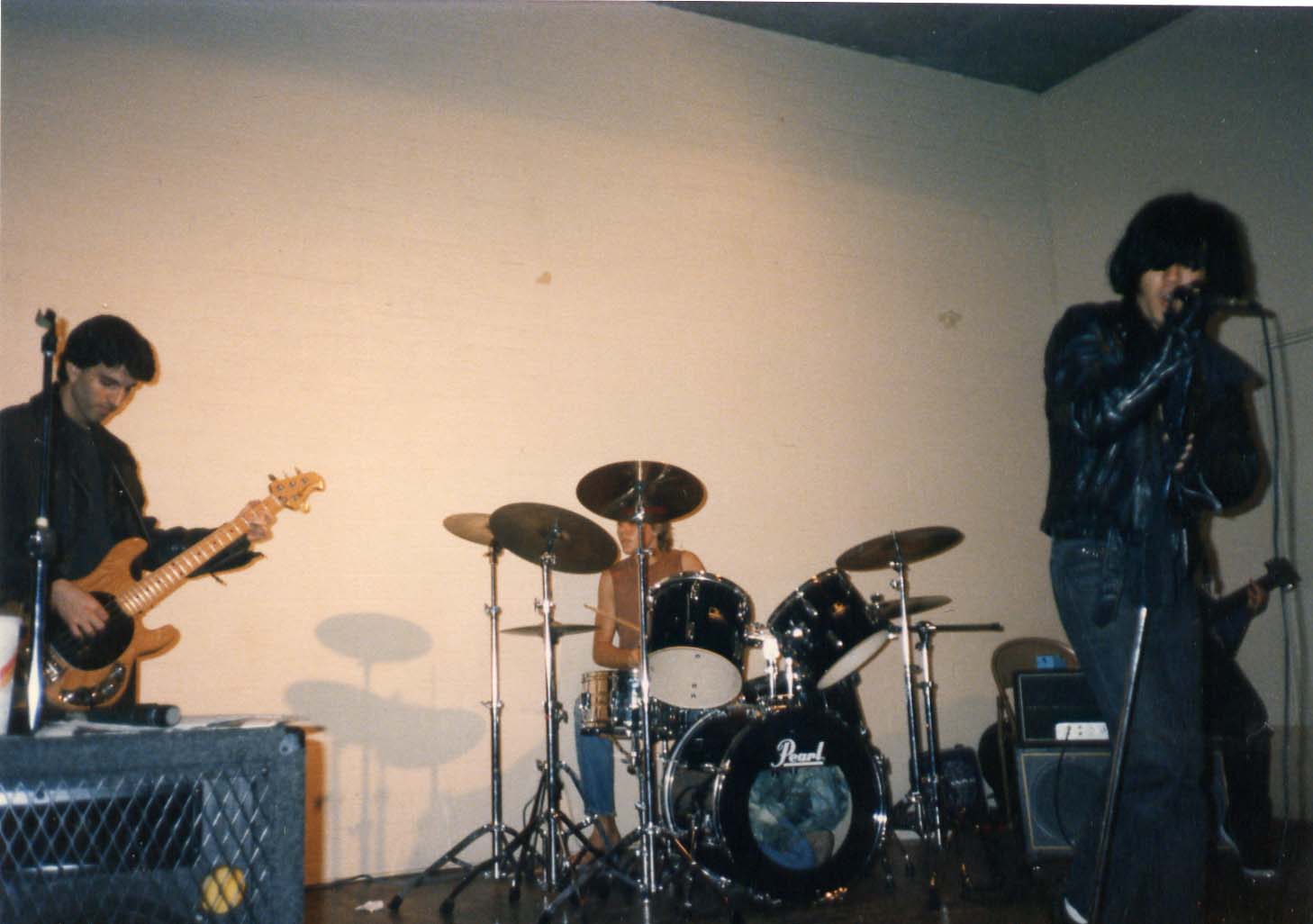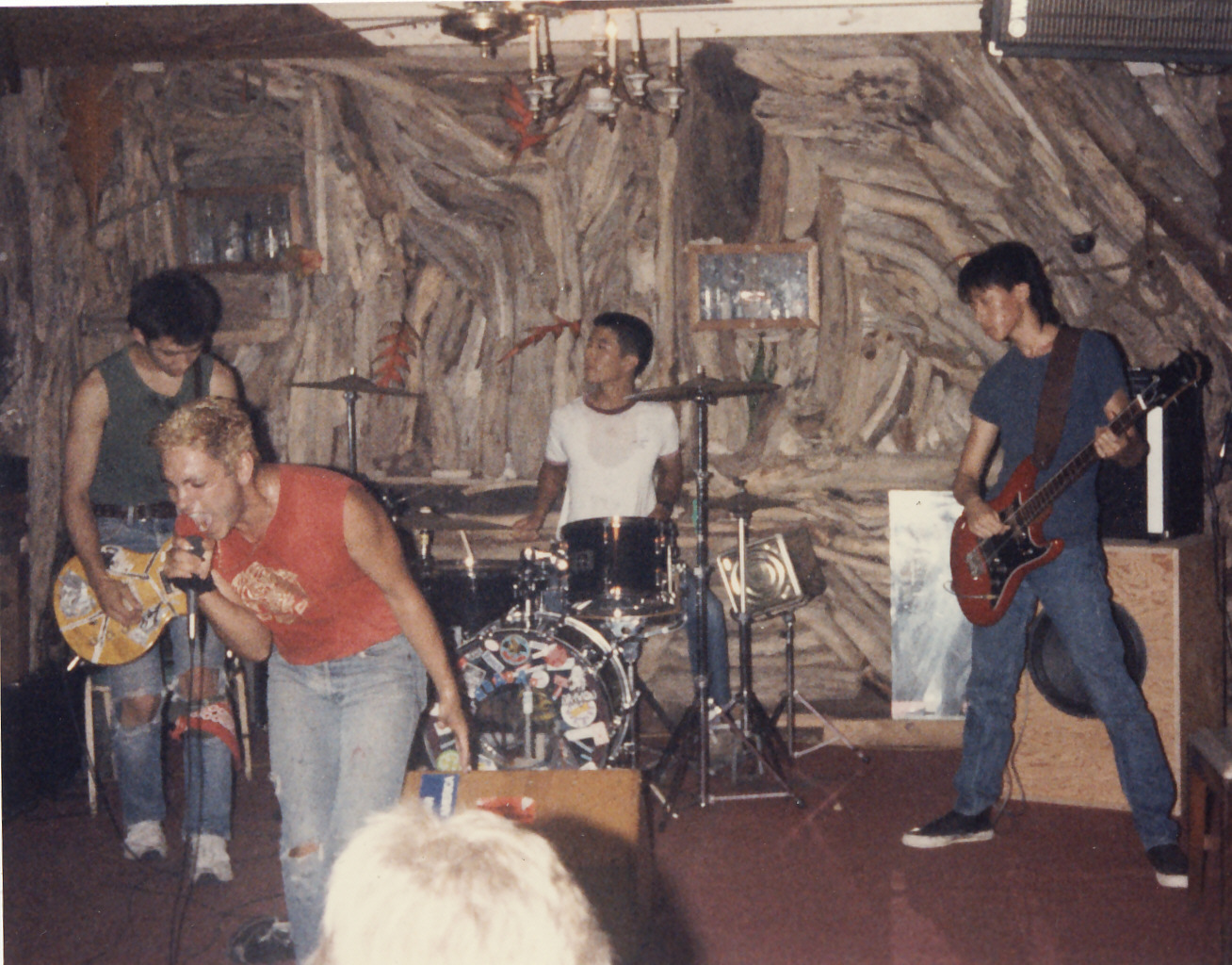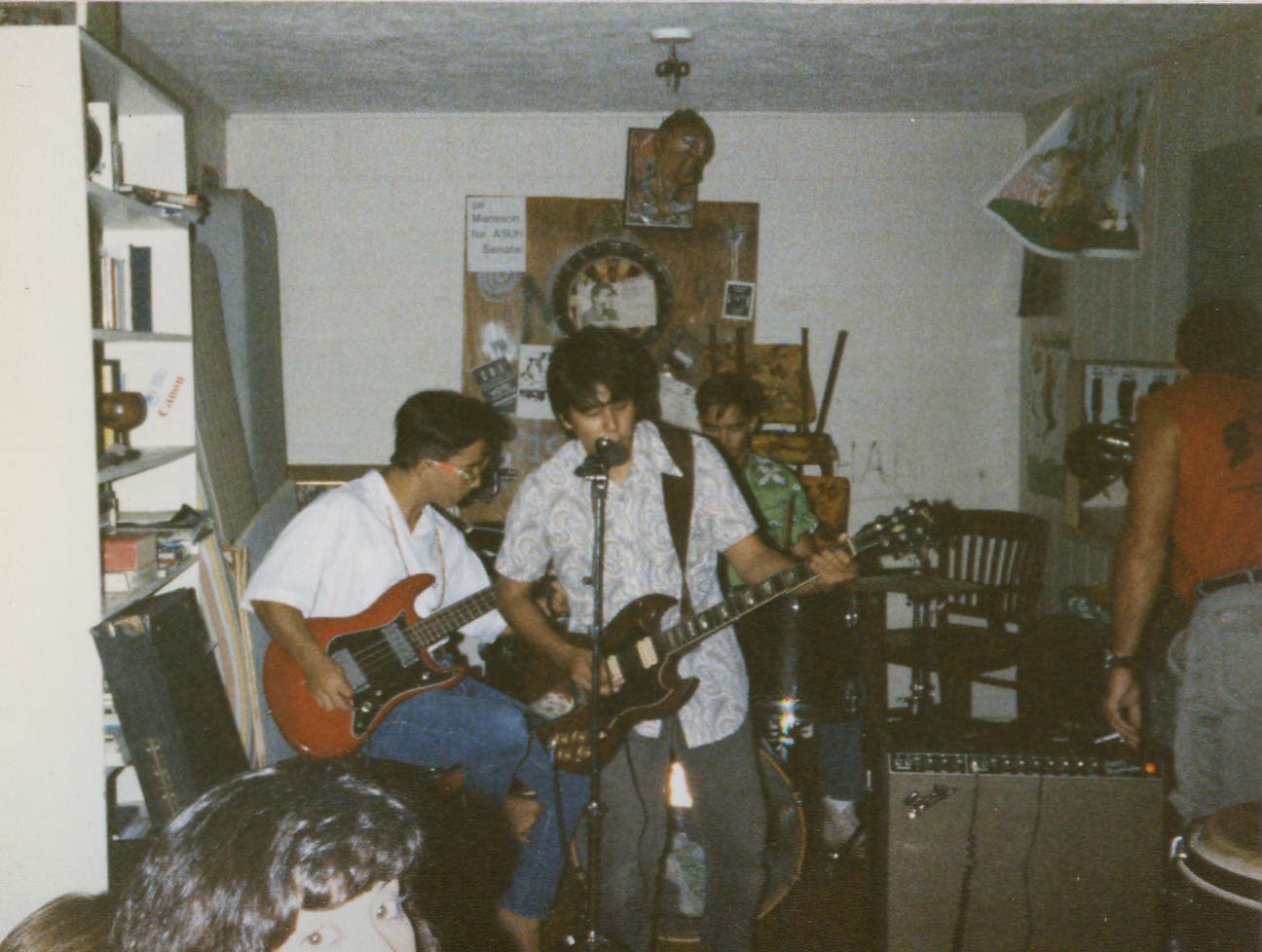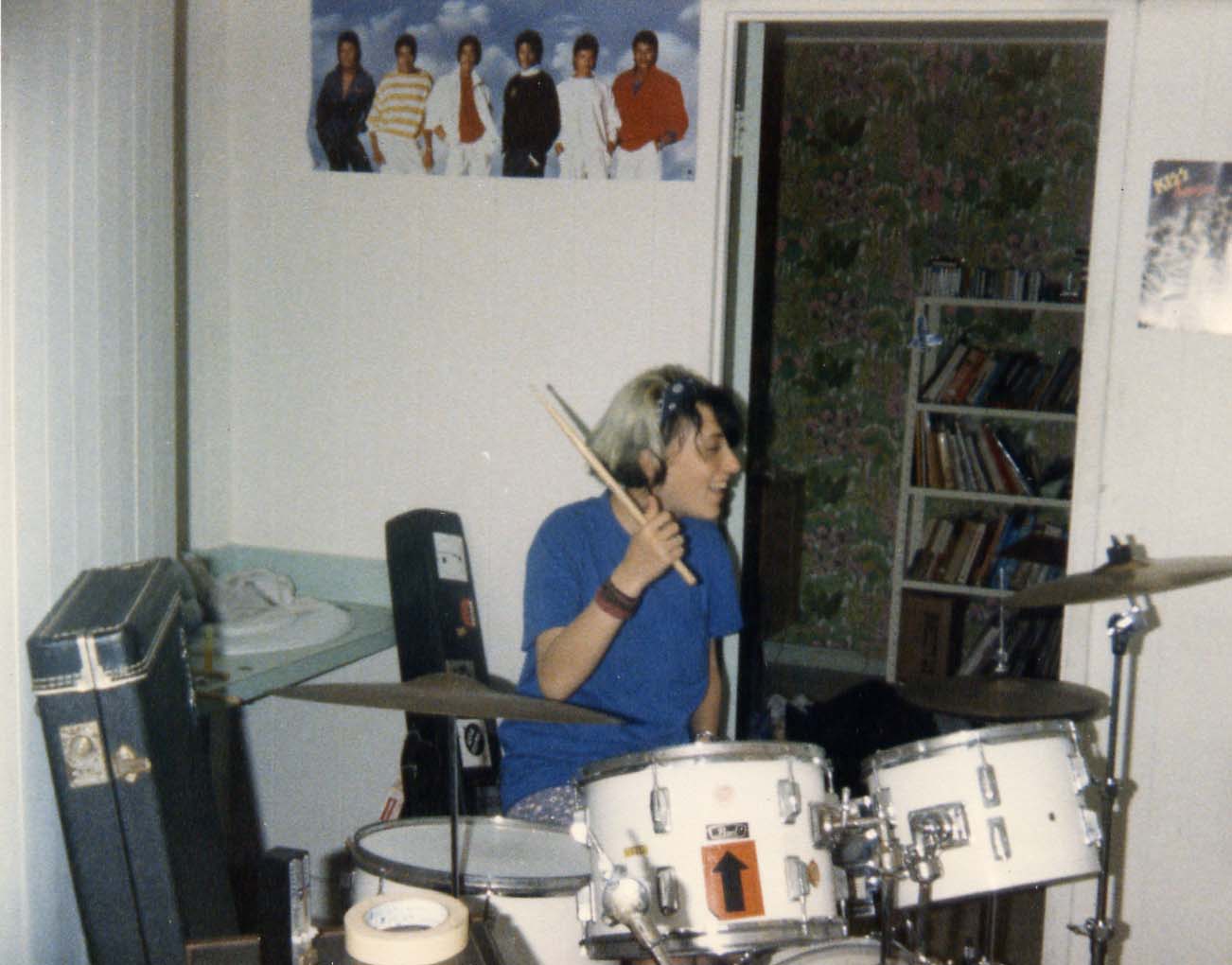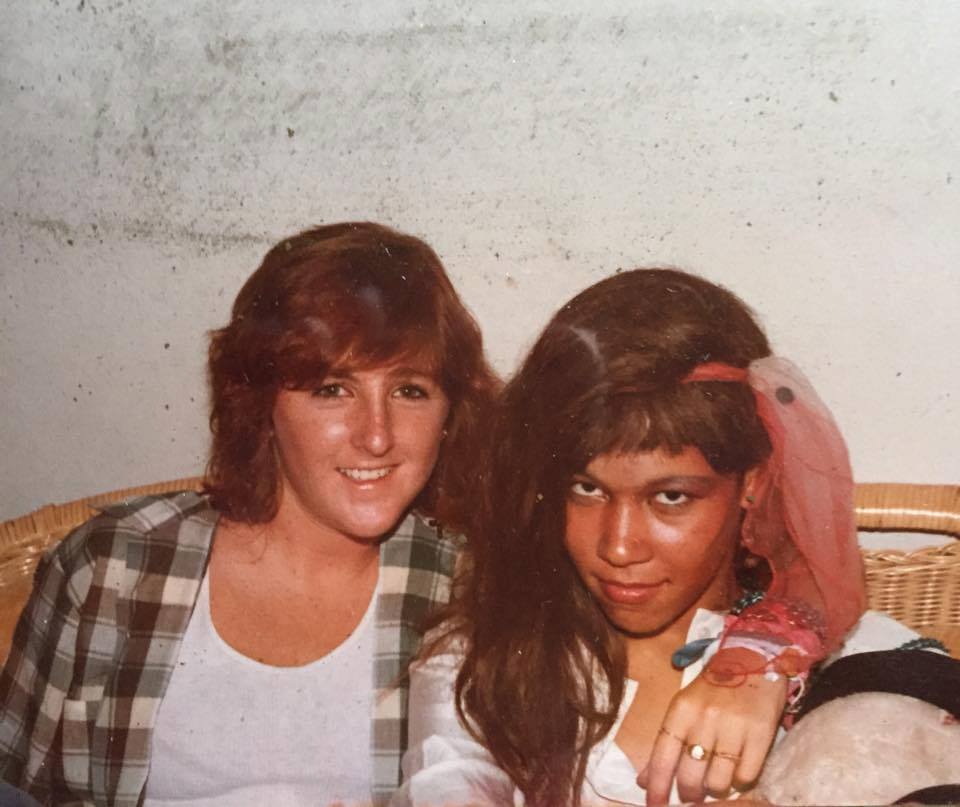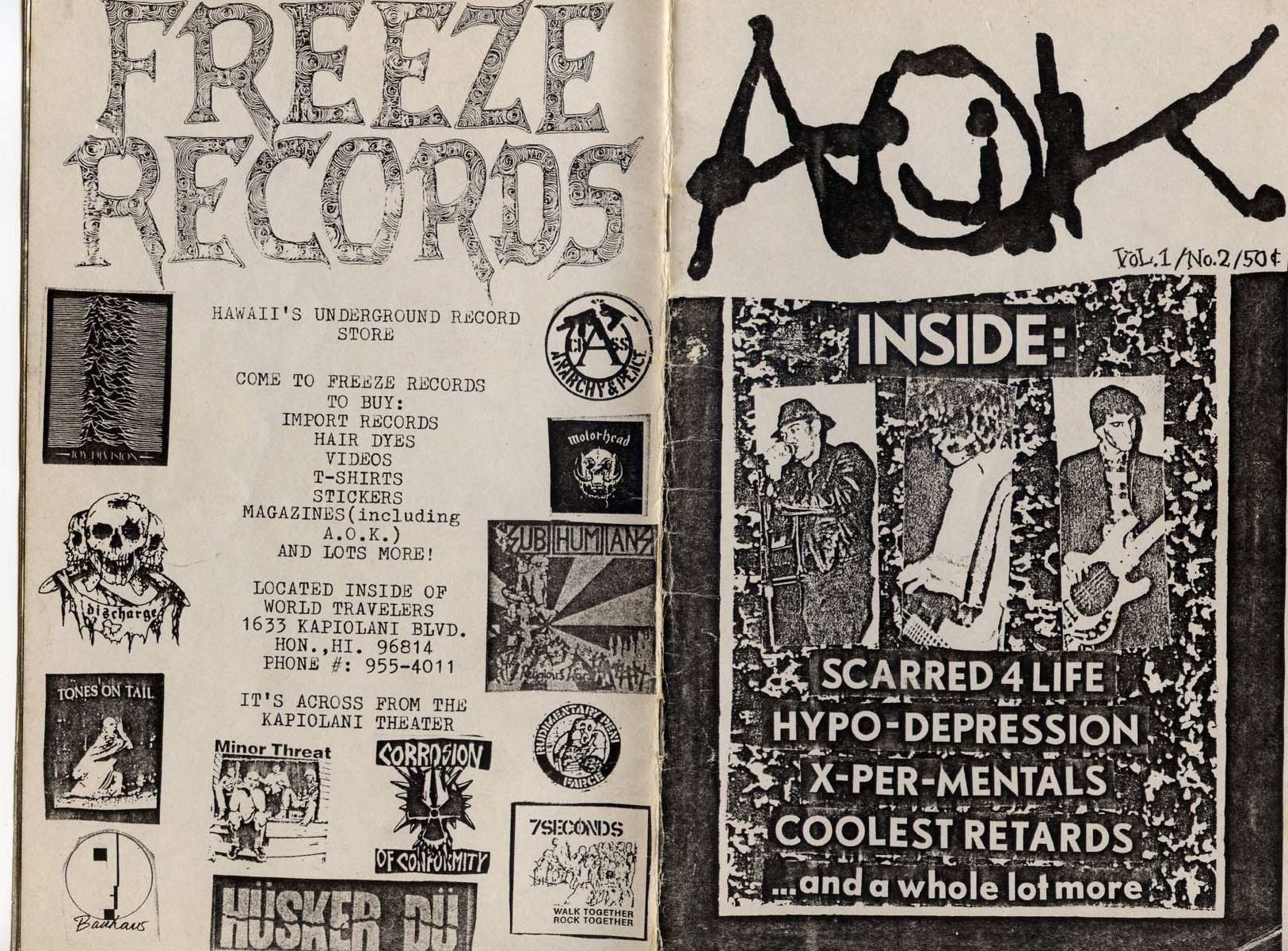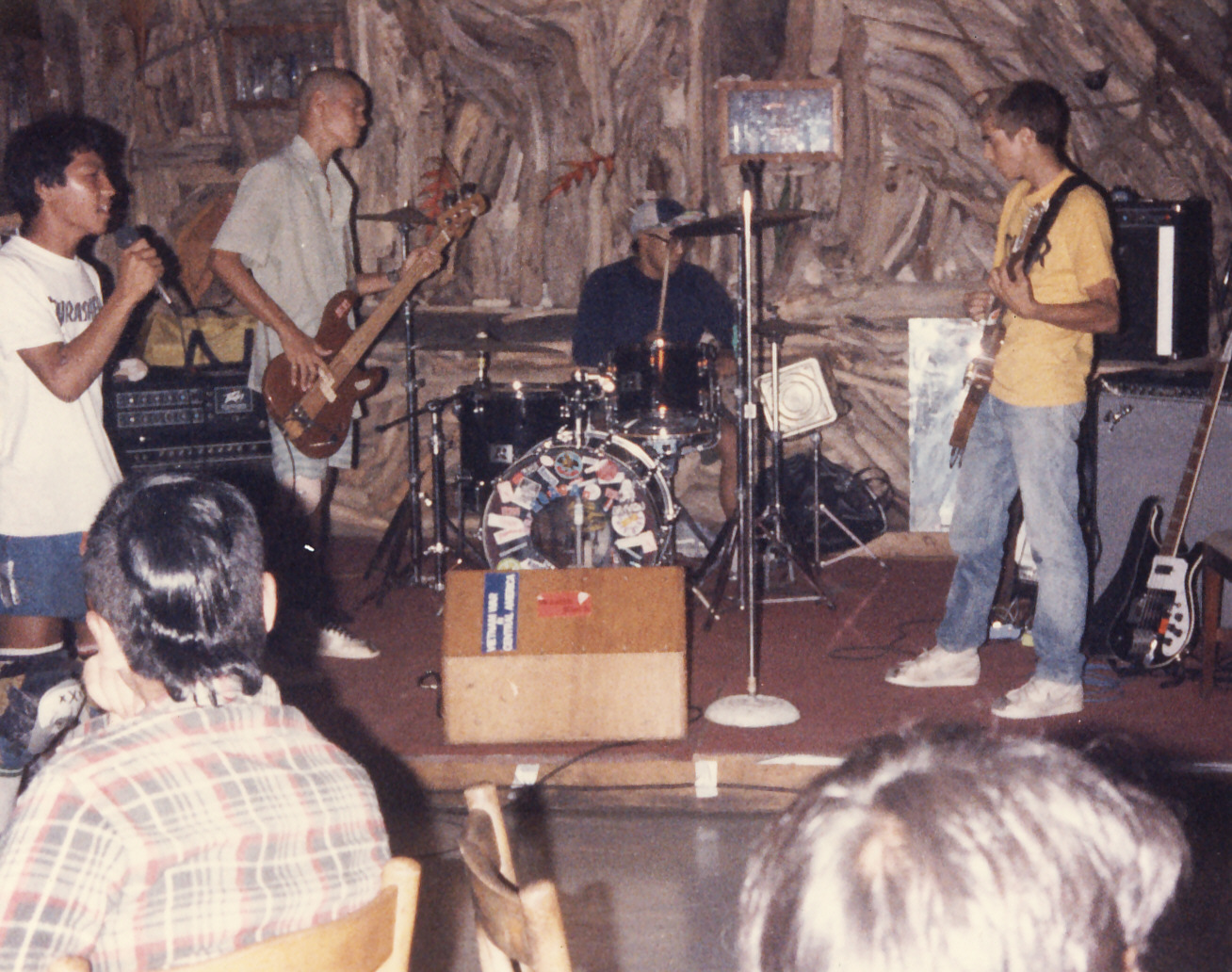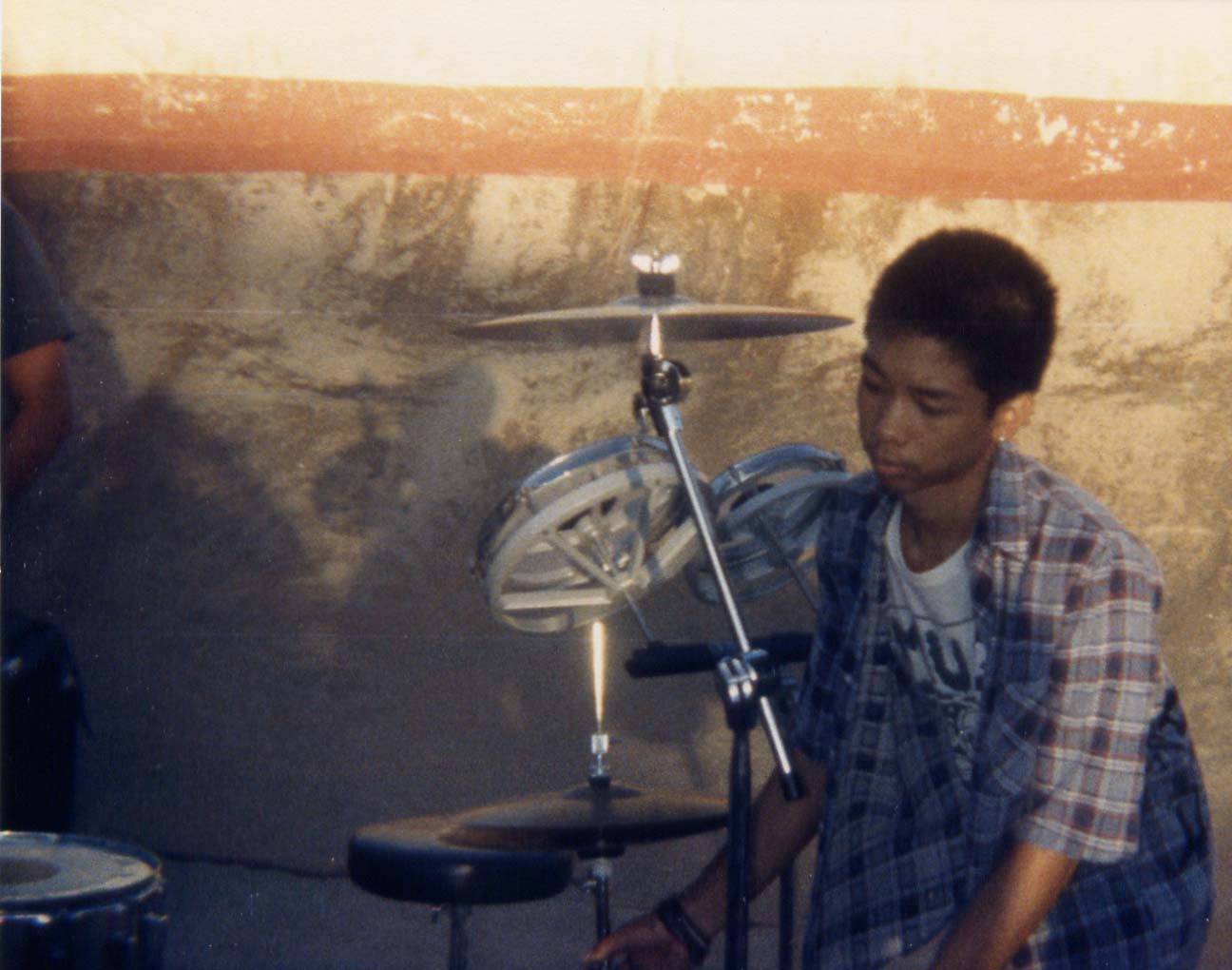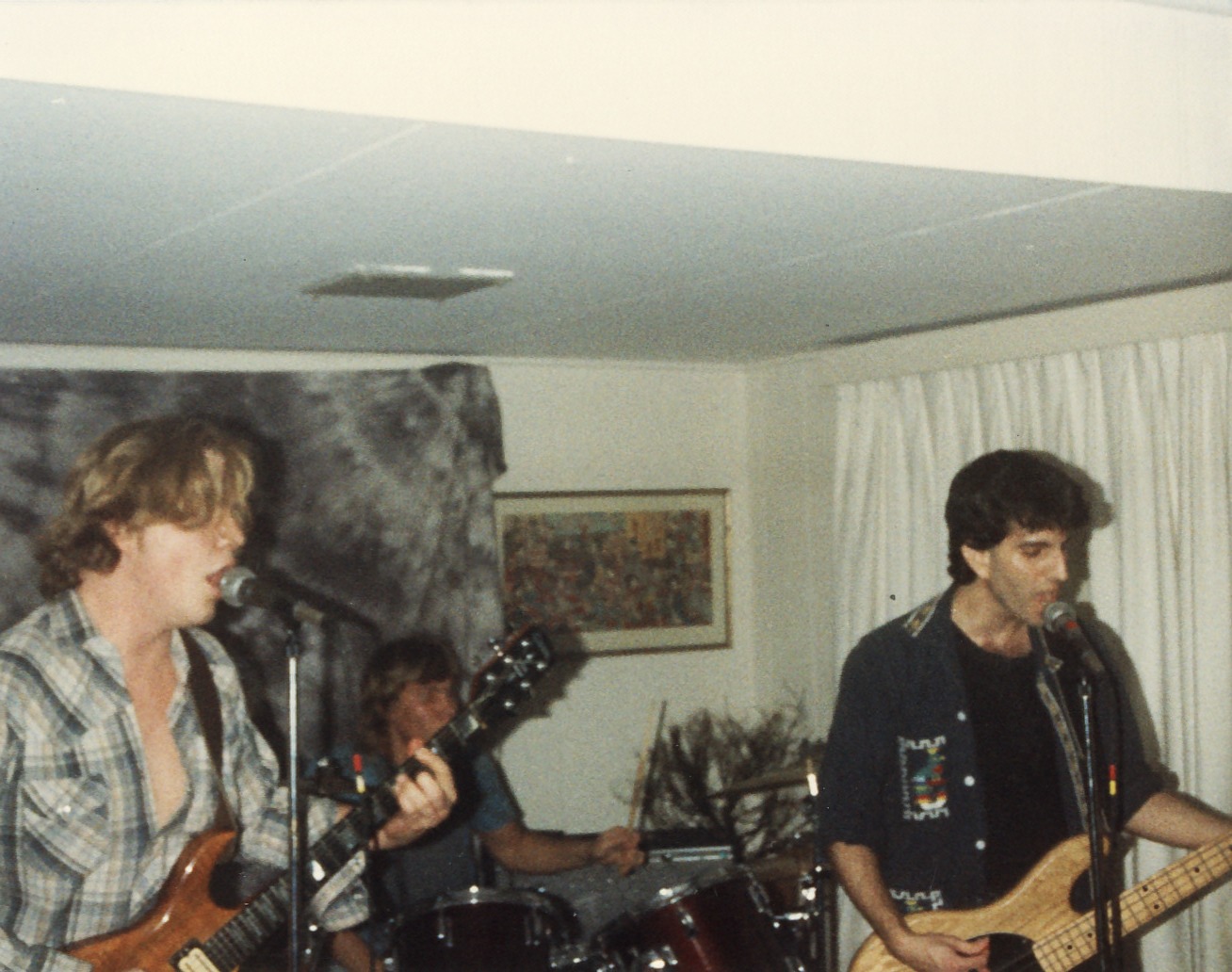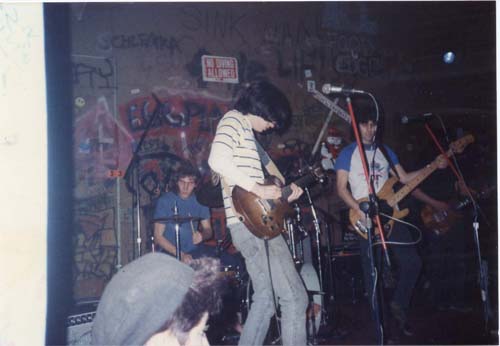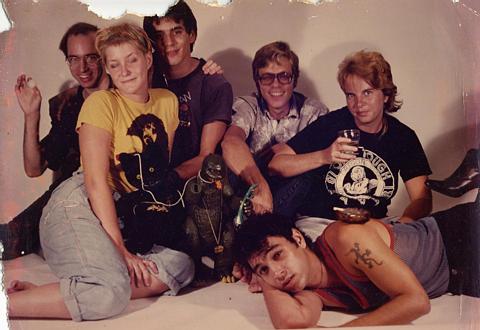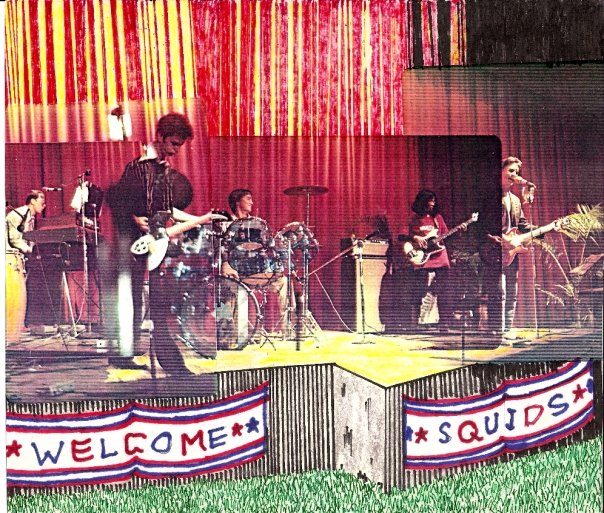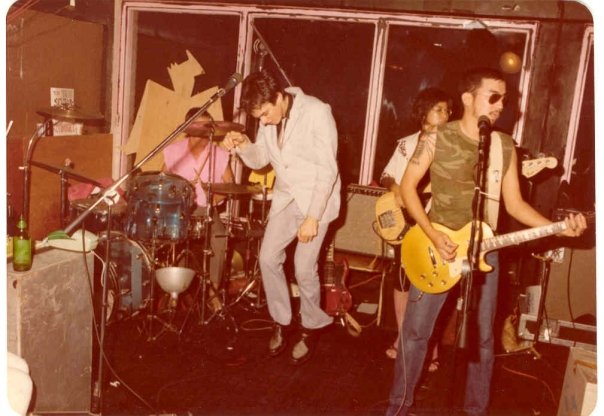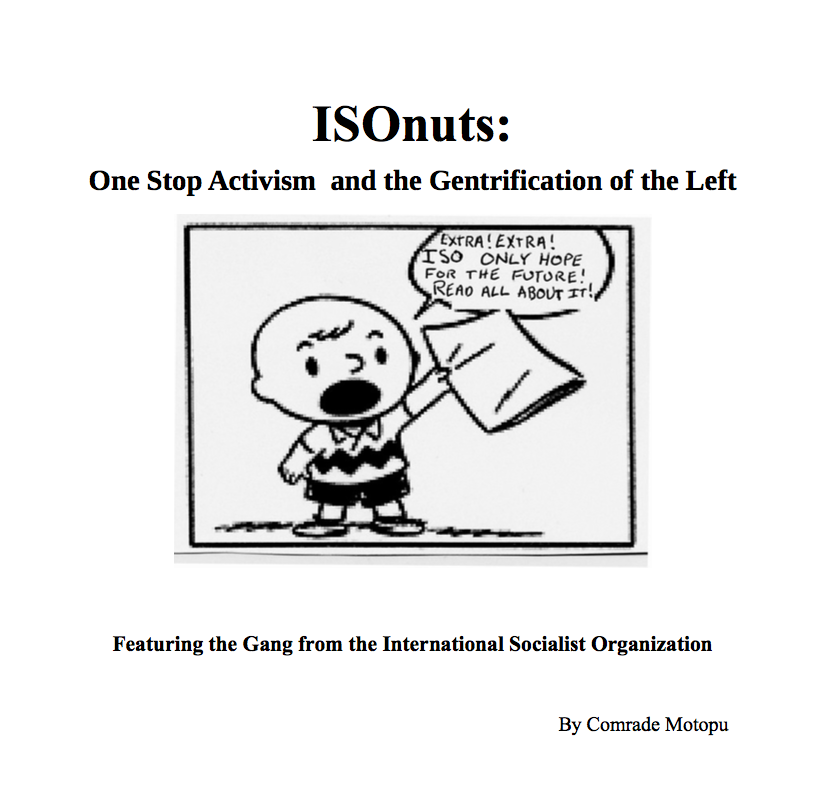|
Interview with Comrade Motopu on the Hawaii Punk Scene in the 1970s and 80s
The Sharx 1983 Interview by Lefty Hooligan, December 2019 Lefty Hooligan: Tell us a bit about yourself by way of introduction: Comrade Motopu: I’m an adjunct professor at a local community college. These days I’m more into class struggle politics and educating than playing music. So I’m your typical professor who used to be a punk, we’re a dime a dozen. I co-founded LaborFest Hawaii (First one was 2012) and worked with them through 2016. Libcom.org has been nice enough to allow me to have a blog on their site. I started playing guitar in the fourth grade(1976), and was into what would be called classic rock today. I got my first good acoustic guitar in 6th grade (1978) and my first electric in 8th grade (1980). I started going to punk shows with my older brother Kevin and his friends, who are five years older. That was in the late 70s. Before punk, my first favorite band was Sha Na Na, who I saw twice at the Honolulu International Center (where I also saw Liza Manelli in the 70s). I was also into classic rock and early metal from Deep Purple to Judas Priest type stuff. The most famous band I played in was Cringer (formed 1985), for whom I drummed, not very well. I won’t say much about Cringer other than that Lance was a great guy and talented. A lot of ink has been spilled about them already!
CM: There is overlap for my own personal musical tastes. I was simultaneously into classic rock and punk and New Wave. I was hanging out with stoners and at the same time listened to 70s punk like the Saints, Dead Boys, Stranglers, Ramones, Dictators, Dickies, etc. when those records were new, from my brother’s collection. So when I started going to New Wave Clubs with a fake ID (1980) I had super long curly rocker hair, and like a Specials shirt or something. Before that though I could see Hawaii punk shows at old warehouses and pizza parlors. So I had been into the music since at least 4th grade, and seeing shows from the time I was 12, in 1978. My high school friends started introducing me to stuff like the Circle Jerks and the Germs. I thought punk had already passed. But then I started hanging out with them and thought of myself as a punk, which was great fun. I was definitely always a poseur, never very cool, never a stud, but playing music allowed me to meet girls, and alcohol helped me overcome the shyness. (These days I drink a beer once every year or two. I’m basically straight edge without it being an ideology.) At some point, probably around 1982, I woke up one morning and took down all my rock posters, and then started selling a lot of my rock albums to buy New Wave and punk stuff. But it wasn’t all “cool stuff,” some of it was just bands from MTV mixed in with the other cooler stuff my friends were into. I started 10th (1982) grade with a haircut, and eventually I went for a blue manic panic with blonde sides haircut (1985) and started wearing trench coats, and button up long sleeve shirts and turtle necks, etc. in Hawaii where it’s warm. So by 85 I was into deathrock and post punk as my main thing. Cut Hawaii punks some slack for being a bit behind sometimes, in the middle of the Pacific, especially pre-internet. In 1984 I was visiting New York and saw a lot of bands. Tones on Tail, the Psychedelic Furs, Live Skull, Hoodoo Gurus, Long Ryders, Kraut, the Cure, 45 Grave, and others. That was my first taste of having access to a scene in a major metropolitan city and by 1986 I was able to move to L.A. to play music. I liked the music scene in Hawaii a lot. Before punk it was heavy metal parties with an older friend and we smoked and drank and had a blast (8th - 10th grade so 1980-82). There were shows at house parties, but also way up on Tantalus, a lookout area overseeing Honolulu in an open air setting with a gas generator to power the amps and PA. Those were mostly cover bands but they meant a lot to us. It was our scene. Smaug was a great band that played Rush, Hendrix, Zep, Triumph, etc. There was another band called Blitzkreig whose singer looked cool but was literally tone deaf (sounded kinda like Cal on Grave New World, ha ha). They played UFO and early YnT. In 8th Grade (1980) I emerged as a rocker and our band won the school talent show playing Zep and Neil Young. The stoners all hung out at the top of the school steps by a place called “The Wall” named after the Pink Floyd album, and we just wrote hundreds of band names on it and were little delinquents, but nice. People who later went on to play in the early punk bands were all in earlier “rock” bands. So there was the Rolling Mango Review(1977 roughly), Zacharia (1977 roughly) (named after the 60s rock film), and others. This scene--mostly around people from “town,” Manoa, the East side of Hawaii, and from schools like Roosevelt, the UH Lab school, etc.--started getting into New Wave and punk around the mid 70s, and their bands transitioned. We did get some really great shows in Hawaii for early New Wave. Devo Played on their “Are We Not Men” tour at the Campus Center Ballroom and to this day was one of my most cherished shows. Talking Heads and B-52s both played at “Little Orphan Annie’s” a dive bar out by the airport, supporting like their first or second albums, but I was too young to get into a bar! Those shows were fuel for early bands to do more. (The Squids got a board mix of the Talking Heads, and were covering one of their songs before it was released on an album!) Early punk bands were also mostly covers. The Rabbits (1977 roughly) played more new wave (like Elvis Costello) than rock. Then bands started adding more originals. The Diamond Heads (1978 roughly), The New Dreamers (1978 or 79), The Tourists, etc. The first new wave band with an extensive set of originals to make a splash came out of this scene. They were called The Squids (1980), a punky new wave band with influences from ska to the Talking Heads, to the Seeds. This was Rudy Trubitt, Kit Ebersbach, Frank Orrall, Rubella Shotz, and Beano Shotz and sometimes theNew Dreamers’ drummer Dave Lassiter, their sound man. They actually put out a four song ep featuring their globally known single “Tourist Riot” that is a collectible authentic punk single to this day. Their EP came out in 1981. That song was a poem by a legendary tattoo artist named Rollo Banks, and Beano’s music and melody.
The next big band was Hat Makes the Man (1982), who had all been in the earlier 70s scene as well, with Peter Bond, Marti Nica Kerton, Matt Miller, Byon Lai, and Frank Orrall. Frank was the youngest of them by a year or so. They started out with mostly covers, especially U2 and REM, and later a lot of Smiths influence , but eventually had two full sets of really good sounding originals. They were offered a major label deal, but on the condition that Frank Orrall was in the band. He had already started Poi Dog Pondering which enjoys international cult fame to this day, so he couldn’t come back. But HMTM are great friends and still play in many bands and do reunion shows every few years. There was an early noise rock band that was very cool called the Fuckin’ Flyin’ A-heads who put out a single in 1980 which is considered an avante garde classic by collectors. I didn’t know about them at the time, and judging from a later interview, they thought they were the only punk band in Hawaii back then, but I think they didn’t know about bands a few miles away from them because they were outside Honolulu. They were possibly the first Hawaii punk band to put out a single. Was this the first "punk" single from Hawaii? Another weird band that existed in the crossover time from rock to New Wave was “Shnazz.” They were led by a local 98 Rock DJ named “The Fritz.” The Fritz kept performing up to the 21st century with Don Tiki, which is the keyboardist from The Squids Exotica Tiki band. His character in that band was an over the top crooner with a giant pompadour. They’re also fairly high profile among Tiki music fans, playing an “Exotica” Martin Denny style blend, even featuring the son of Auggie Colon (the guy who created the bird calls for Martin Denny’s original band) on percussion. Martin Denny even played on a couple of Don Tiki tracks on one of their albums.They have hula dancers, and great female musicians and singers, it’s an elaborate show they put on in Waikiki ballroom type venues.
New Wave Rockers: Shnazz My brother was part of the early punk scene, writing and recording songs with a lot of those musicians, but especially with Rudy Trubitt. I, as the little brother, got to play with them too once I got good enough on guitar. We both worked up our chops in the earlier scene. The second generation of punks included me and my brother. We had already been going to the first gen shows, but as I said I was also into rock. So when I started hanging out with punks “my own age,” it was all short hair and spikes hardcore people, and I would get shit about long hair, so I cut it off to conform! The first hardcore band I was aware of was one of my all time favorites, The Sharx (1982). That was my high school friend Barry Freeze, Davin Neubacher (who replaced Johnny Kopp on drums, later in Chokebore), Gardner Pope (later Cringer/J-Church), and Brian Walls (later Goat Guys from Hell). They were a hardcore band but Brian was a totally shredding/wanking metal guitarist, so they were accidentally right up to date with the “mainland” bands that started fusing metal and punk. Barry’s vocals sounded a bit like the guy from the Adolescents. Barry is a superstar who literally everyone on the planet loves for his down to earth demeanor and cool style.
Jon Lange was one of the best flyer artists of the hardcore scene in Hawaii. The other main hardcore band was SRO (Something Really Offensive) with Dave Moffat, Chris Owens, Ed Moya, Davin Neubacher (followed by Charlie Palumbo on drums), and Tom Clerks (first bass player). They were almost all originals in a kind of mix of Social Distortion with a bit more psychedelic influence on some of the guitars, but a great band with solid songs. They were a bit more like skaters and surfers. Owens is from a famous family of skaters and North Shore surfers, and they would hang out with the early Dog Town scene which I know very little about. But they did stuff like drain pools, before that was a major trend, and there were Hawaii and L.A. connections.
SRO: Ed, Chris, Charlie, Dave Another early and important hardcore band was The Efekt with John Bopp on vocals, Russel Roper on guitar, Jon Lange on bass, and Lord Veerman on drums. They started up around the same time as SRO and played at gigs and house parties. Their smash hit was "I hate my Vans."
The Efekt at Anna Banana's Barry Freeze was a trend setter, and he’d been seriously into punk since like 1980 being younger. It was understood that if he liked something it was cool. He was pen pals with a lot of early hardcore punks. He knew all the L.A. hardcore stuff. Back then you see, knowing bands was difficult. There was no MTV, but there was like Radio 1990, Night Flight, New Wave Theater, and local bands. You had to read MRR, Flip Side, and have the initiative to order stuff via snail mail, and write to bands and stuff like that. So anyway, Barry knew more about punk music than most, and I think our friends Liz and Gretchen were an influence on him and the scene too. To be fair, everyone who participates in a small local scene is important and makes a splash, but I’m just singling out individuals in my personal orbit. Barry would silkscreen his own punk shirts, so no one else had them. He screened his own leather jacket with the Discharge logo on the sleeve and “Noise Not Music” on the back, and that was around 1982. There was no Hot Topic so a lot of it was DIY. By 1985 Barry opened up a weird store called Action Sundries. His mom and Grandma had a sundries near Ala Moana and they helped him start his. It lasted about a year. He sold shave ice and snacks, manic panic hair dye, and punk and death rock records! I remember people from Tower coming to see what he was selling because they wanted to see what was new and cool. Jim Neighbors came in and bought a mud pie and Francis Sipin put the wrapper up on the wall with a sign that read “Jim Neighbors Mud Pie Wrapper” just to indicate the sort of irreverent attitude of the place, ha ha. A lot of punks would just hang out there.
Barry and his Devil Lock, 1983. There was a club called 3D (opened 1979?) that was a kind of early punk and New Wave club that lasted through to the Hardcore period. The Squids and a band called “Obscene Routine” and others played there, and later the Sharx did a gig there. Bow Wow Wow did a gig there! The original line up of Agent Orange, played there too, around 1983, as did the Circle Jerks around that same time on the “Golden Shower of Hits” tour. A funny story from that club was local skate punk and early death rock fan (for Hawaii) Gary Owens walking up to a woman and telling her in a laughing voice “You look like Siouxsie.” She looked at him with disdain and said “I am,” and walked away. That was when The Creatures were in Hawaii and put out that silly album, which was kind of interesting I guess. There are other photos with Gary and other punks partying with a young Madonna on the beach.
Liz, circa 1984
Tamara, radical political performance artist There was a mod scene in Hawaii too! Probably about 20 kids were able to get 1960s era Vespas into running condition. They dressed mod, trenchcoats or parkas, Basically Quadrophenia and that second wave mod style. That was around 1980-83.
Frank Orrall and his scooter, circa 1982. Senior year of high school, 1983-84, I started a covers band, originally called “Huck Melody and the Astro-Chimps” but later changed to the more sensible “The Start” when we decided we were kinda mods. We did have a lot of Jam covers, but also Gary Numan, Sham 69, the Monkees, the Who, REM, English Beat, the Saints, etc. Also in senior year, after the Start broke up, I got more into Joy Division type stuff. Early on in my songwriting career, like around 1980, I bought a half track reel to reel recorder from a local record collector dude. You could “bounce” tracks for overdubs, and so we used that to record songs. I had a bass, guitar, and a (hardly) used drum kit, so we were set. By late 1984, I decided I had enough original songs to start a band. The Vacuum formed in 1985, I recruited Gardner from the Sharx, and Frank Orrall from the Squids and Hat Makes the Man. We put out a demo in 1985 that sold 500 copies, a major smash hit in our small scene. Actually I had already moved to L.A. to continue The Vacuum with Gardner there. My Dad kept printing more copies of the tape as they sold out, so he was largely responsible for our success! They were sold out of a local record store called Jellys. The Vacuum were fairly stylish and had good songs. We were all over the place, from Joy Division to Bob Dylan, and yet people got pretty excited about it. Putting aside humility, I think that tape may be one of the most solid things to come out of the second wave scene. Song for song it’s extremely listenable, and even though some of it is derivative, there wasn’t really anything like it in Hawaii at the time (but there would be shortly after). Nowadays there seems to be more nostalgia for the cut and dry hardcore stuff, which is seen as more authentic, and that’s fine. The Vacuum gigs, and there were only like 5 or 6 total, were very popular. Our last gig was in Kalihi at the Puerto Rican Association Hall (a group my mom helped start) and there were hundreds of people there (including my parents). We headlined and people literally sat down on the floor facing the stage to watch the whole thing. It was pretty cool. That was in 1985, Gardner Pope on bass, Frank Orrall on drums, and me on guitar and vocals. It was a small scene, so when the demo tape came out, people snapped it up and word of mouth made us a success.
The Vacuum at Anna Banana's
Emily outside 7-11 Waikiki. Later a Yard Dogs Road Show performer in SF.
Kim, later on bass for The Million Kids in Los Angeles Back to Hawaii, Hypo-Depression started in 1985, as the Vacuum was winding down. Hypo is one of my favorite ever bands. I helped start it with Gardner and Lance and Barry on vocals. It was my idea to start a straight up death rock band with Barry, who was really into that music and had turned us on to a lot of it. When Gardner and I moved to L.A. Rob Cribley came in on drums and my brother Kevin took the band from three songs to a full set as the main writer, and I guess his being a writer with an English degree helped take them to a whole new level. Great death rock psychedelia.
Hypo-Depression at the University YWCA, 1986: Kev, Rob, Barry They put out a classic (1986) demo called “Spirit of the Dead.” I remember film maker Jon Moritsugu telling me he heard that tape when he went back to visit in Hawaii and thought it was cool that there was a Joy Division in Hawaii now. Barry actually had a very Sisters of Mercy type voice, but still original sounding.
Lance on guitar Devil Dog was another amazing band, Raul Vehill, Don Upton, Keith Potter, and a revolving door of good drummers. They had been around a few years before releasing their (1986) demo “Bad Trippin.” It’s as tight as a Black Flag album, with a whole set of death rock tinged punk.
First Devil Dog line up at Anna Banana's around 1985: Byron, Raoul, Glen, Wendell
Devil Dog with Don, Raoul, Roger
I like the 1983 -1986 Hawaii scene a lot. 1985-86 was a high point in my view with the Vacuum, Whirling Dervishes, Hypo-Depression, SRO, MUG, all putting out solid demos.
Whirling Dervishes at a Manoa house party in 1985 Also in 1985-86 a bunch of Vegan punks created bands. Just In Fun (JIF) was the Kroll Brothers (later in Chokebore) with pro-skater (and nice guy) Bo Ikeda on drums and Matt Saud on vocals. Matt had one of the best Baritone snarls and the Krolls naive musicianship gave the whole thing an eerie sound almost reminiscent of Rudimentary Peni. Same for the political vegan band Free Will, which was also the guitar bass stylings of the Krolls, with very cool looking lead screamer Francis Sippin providing powerful vocals and a strong (all green clothing) stage presence. They had a lively show and would jump around a lot and collapse into each other. Jon Kroll is a great artist so they had cool banners and artwork for their demos for both JIF and Free Will. Lance was the drummer for Free Will and sounded like he was playing for Crass. Weirdly enough, when the Krolls and Troy Miller (known to us as “Raya’s brother) started Chokebore, they had another pro-skater on drums, Johnny Kopp, who became a tennis pro and moved to China to be a tennis instructor.
The JIF booklet was issued as an issue of "AOK" zine
Raya on the drums. She has never achieved anything of note. I'M KIDDING! She's a multi-skilled artist and comedian.
Julie Reed and Sumiko Saulson (with red scarf). Sumiko is an award winning Goth, punk, and horror author, published "Sects Kit-10" an early second wave Hawaii punk zine, and was also in the band Poetic Justice. In 1986 “AOK” fanzine started up. That was Francis, the Krolls, Jackie, Heather and Lance Hahn, Kev, Gardner, and I even got to contribute a bit. The L.A. connections were starting up at that point so there were scene reports from there, and there were interviews with mainland bands Lance communicated with. Some of those are up on the Hawaii Punk Museum. Speaking of which, the Hawaii Punk Museum is something I put together when I learned basic web design in a statistics for history class I was taking at SF State in 2003. I kept adding pictures, flyers, and mp3s to it, until they kicked me off their server. It’s terribly designed, which is hopefully somewhat charming.
AOK zine #2, 1986 Ed and Rich Tarantino were punks from the Bay Area who had moved to Oahu and they skated and ran a record store called “Thrash and Scratch” (1984-85) out of their trunk. In a way this was a transition from second to third wave music as they had already been in the mainland hardcore scene, seeing tons of bands, but would play in thrash and metal core bands in Hawaii. Black Sabbath was a big influence on them. They were in Lance Hahn’s first hardcore band Scarred 4 Life (1984), which continued on as a metal band for a while, with many loyal fans.
Scarred 4 Life with different lineups The third wave, if there were discernible waves, was more metal influence. Another thrashcore band was Mean Ugly Guys, MUG, (1985) who may have out intensified all who came before.
Raymond of M.U.G By 1988 another thrash metal band called Broken Man with Randy Szuchs and Jaime Ikeda emerged and became very popular. It’s worth noting that while Hawaii high school student cliques often break down along ethnic lines, Haole (basically meaning “white”), Japanese, Filipino, Hawaiian, etc., the punks came from every ethnic background around the music. That’s brilliant, a built in anti-racism. And yet, because the island also breaks down into ethnic communities, the “East side” scene I was in was more “haole” and Asian less “local.” But it was still an ethnically diverse group. When I say local, you could measure this by who speaks pidgin and who does not. Any kid in Hawaii who got into punk was obviously into some “mainland” and or European style tunes, and most haole kids know how to at least ironically speak pidgin but there were still cultural differences among various sections of the scene. Again, it was such a small scene that we all hung out together. The good thing about that is the solidarity, or maybe “unity” is a better term. The bad thing was that even the bully boy skins, some military assholes, and some racists, etc. hung out. Eventually there was a kind of skinhead scene and it just continued the evolution of our punk scene after mostly the model of the West Coast. On the good side of that trend were bands like MUG, who were anti-racist, but some people got into dumb shit like Skrewdriver and so you had the bizarre phenomenon of Hawaiian and non-white white supremacists. It made no sense, but when do fascists ever make sense? And yet the scene was so small you couldn’t avoid them. No offense to the anti-racist skins! As things got more macho and more new metal (by my standards, not actual nu metal) I had already left the island to L.A. There Cringer succeeded but the Vacuum ended and I moved back to Hawaii. In 1987 I joined my brothers band “The Wrong” which was a very cool three piece doing “77 style” punk, tight little fast songs that stick in your head, but with other psychedelic and rock influences snuck in. The name was given by Gary Owens who told my brother “You guys are so wrong you’re right.” We became a four piece and moved to SF where we put out an album (Flux Records, L.A.) in 1988, and ended up on several Very Small Records comps, because David Hayes liked us.
Early Wrong gig in Aina Haina 1986
The Wrong at Gilman Street 1988 After that I started Yahweh’s Mistake which had the powerhouse drumming of Rob Cribley and eventually Ed from Cringer on bass (replacing Alex). We recorded a lot of demos with various members, put out a 7” (1992), and then CD (1996) with Rudy Trubitt on guitar when we were a four piece, and John Nelson on drums, also an amazing musician. We were also on a Very Small Records comp. Both John Nelson and Frank Orrall became the touring percussion section for Thievery Corporation and still do their popular band Poi Dog Pondering. The last recording project I did was in 2006 with Ed on bass, Jim and Rob Cribley, and myself as song writer, called “Creation Science.” LH: I get the impression from the above that punk/new wave scene in Hawaii happened later and the music was more compressed. Styles of music came from the mainland later and overlapped more as a result. Would it be fair to say that punk/new wave/hardcore all started emerging more or less simultaneously after 1979? CM: No, because so many of the bands were already listening to that music. Byron from New Dreamers was at the Sex Pistols Gig in Texas. Beano had been in New York for a while around CBGBs. It just took a while for bands that were punk, with original sets, to have places to play. I don’t want to give the impression that people in Hawaii suddenly realized there was this thing called punk in 1979, like we had all the records as they came out, at least the major label ones. It was harder to get indie stuff, like most other places. Hawaii is more isolated, and was generally behind a few years, but for the people into the scene, they knew about the music. We didn’t have a Rodney on the Roq. I didn’t listen to college stations back then because we didn’t get KTUH in Aina Haina unless the wind blew the right way, ha ha. Probably the biggest info source was late night tv and like King Biscuit Power Hour on FM radio at odd hours, plus friends who’d been to the mainland. The rock bands were playing Tom Petty, Elvis Costello, Kinks, Stranglers, etc. probably by around 1977, when they started going away from the Skynrd, Deep Purple and Zep stuff. There were garage bands in Hawaii in the 60s sounding like Paul Revere, the Kinks, or the Sonics, so there were the garage precursors even here.
Kit in Zappa shirt and Raoul lying down at the Manoa Hilton where some KTUH DJ's lived. LH: Were Honolulu Dogs precursors? Early punks? Pre-punks? CM: I don’t know enough about them. But I have an article on the Hawaii Punk Museum that one of their members sent me.
CM: The Squids were very important. Kit Ebersbach is the person who put it together. He’s the keyboardist, a very musically trained guy. He was in previous New Wave bands, Fred, and also The Tourists. The latter featured now world renowned bassist Benny Rietveld, a jazz master who played with Miles Davis for years, and with Carlos Santana. They found Frank Orrall from cover bands in Hawaii Kai, and people were amazed at his drumming. It was just the most rock solid thing anyone had ever heard in the scene, but modern sounding for the time, plus the charisma and humor he exuded. I know Kit said the Squids were the most photogenic group of people he ever played with. Rudy Trubitt looked very mod, had a cool Rickenbacker, and could jump really high, as well as being a great player. To me, Rudy Trubitt is the emblematic Punky New Wave guy of the first wave scene, having played in so many early bands, all of which sounded great. Beano Shots wrote the music for Tourist Riot which puts the Squids on the global punk map. The whole band rules.
Squids at the UH Campus Center Ballroom Their first gig was at the Campus Center Ball Room at the University of Hawaii, I think 1980. It was a small crowd of mostly friends. They played at small venues. I remember seeing them at Papa Ninos pizza parlor in Hawaii Kai. I went to that gig with my brother and our mom! Very wholesome. They became the house band at 3D. One of their trademark moments each night was playing the theme song from a Japanese super hero show called “Kikaida.” Rudy sang it and wore a Kikaida mask and people would go into a frenzy. This was a mid 1970s Japanese super hero show about a human looking character who transformed into a robot who looked like Ultraman. Apparently more than 50% of Hawaii’s population watched every week when a new episode aired, it was that popular.
The Squids at 3-D club, 1981 3D was a legendary Hawaii punk club run by two sleazy dudes (kind of a punk compliment) named Kit and Cale. Kit once jumped up and sucked his own dick in public at 3D in a crazed frenzy. Cale was the businessman, a leather dealer among other things, and a club owner. They always let obviously underage kids in, and I had a fake id that usually worked. Good place. Maybe around 1982, the Squids got a house gig at The Wave, a more posh new wave club run by a higher end capitalist dude named Jack Lawless. They put out a 7’ that got a lot of airplay, but maybe took it as far as you could go in Hawaii without relocating to the “mainland.” But “Tourist Riot” cemented their place in the early punk hall of fame globally for record collectors. A real 7” from 1981 and it kicks ass.
Kit went on to form Don Tiki, as I mentioned. Frank formed Poi Dog Pondering, who toured colleges in a couple of beat up cars and busked on the street before being signed by Texas Hotel and then a major label. Rudy plays in a lot of children’s bands, like the Sippy Cups, but also plays folk music with many people in the Bay Area. Beano plays in a lot of surf bands and put out a couple of solo CDs of indy rock that were acclaimed locally. I don’t know about Rubella Shotz, but I think she played in Don Tiki. LH: Re: your brother Kevin. You hung out with Kevin, went to shows with him and his friends, were in several bands with him, etc. Yet I assume you had your own friends and your own activities. Were you always the “kid brother” or was there some sibling rivalry? When did you start differentiating yourself from him and going out on your own? CM: No comment on any sibling rivalry, which must be pretty common. The sibling solidarity is the main thing. My brother Kevin was the main influence on me growing up, for humor, taste in music, and most other things. He had all the punk and New Wave records I listened to. I think both of our all time favorite album is The Saints “Eternally Yours.” Credit to our (slightly) older sisters too, who also liked both rock and punk. But I was always tagging along with Kevin and his friends, who just happened to be the heart of the early Hawaii punk and new wave scene. One of my favorite Squids songs is “Head in the Sand,” which my brother wrote the lyrics for, and Rudy put the music to it, then the band totally fleshed it out. Kev did a performance of one of his songs with The New Dreamers, “Crazy Dreams” at a warehouse party in, I think 1979. That was great. I remember Rudy’s sister, Lisa, there on a dog leash with her friend. She looked very Rocky Horror with long Loraine Newman hair and a dead expression. James Anthony held the leash, and his family are activists of some fame in Hawaii and the Bay Area.
CM: I personally never really connected politics to my song writing. The closest I came was my last ever band, Creation Science (2006 CD), which had about 50% political songs, pretty much anarchisty, because by then I was re-engaging with politics, reading the Situationists, anarchists, and that would lead to Marxist and labor history. But that was in my late 30s, after I had gone back to college in 1996. Between the time in the Nuclear weapons freeze, 1986-1988, and 1996 I was more apolitical, but still basically on the left. As a high school kid I had been a “Reagan and nuclear war are bad” type, and always hated militarism, getting into mild verbal altercations with right wing Christian missionaries and military recruiters at my high school. I don’t think I wanted to make political punk. The attitude of punk fit with rebelling against authority and that was enough for me at the time. It was more about being an outsider. When a bunch of us moved to L.A. in 1986 I was not heavily steeped in political punk indie anarchist stuff although I liked Crass and Discharge and a bunch of other bands, but it grew on me. I was more into post punk type, and first gen punk stuff than political punk. That’s just me, and I do love a lot of the now old anarchist punk stuff, it just wasn’t my main focus. Lance Hahn started working for SANE, the nuclear weapons freeze movement and I became a canvasser too. The guitarist for Econochrist was in that crew for a while too. Pretty much everyone who worked there was interesting though. I learned a lot and we focussed on the Comprehensive Test Ban Treaty, as well as a big push to halt Contra Aid. I did that on and off from 1986 to 1989, in both Los Angeles and the Bay Area. I later found out that was founded by Tony Mazzocchi, who helped found the US Labor Party. I wish I had been more politically grounded back then but it was a part of the process. Canvassing door to door for low pay, having to meet quota and get enough members and contributions will definitely burn people out though. I think the Nuclear Freeze Movement helped ratchet down militarism and nuclear brinkmanship at the time, or so I’ve read.
I also wrote an infamous booklet called “ISOnuts: One Stop Activism and the Gentrification of the Left, featuring the gang from the International Socialist Organization.” It featured detourned peanuts comics and was a decent read if overly long, but it was the start of my anti-sectarian ultra-Left status. Kevin Keating described it as a fight over chocolate milk in the school cafeteria, but I did sell many copies at the Anarchist Book Fair in SF when those used to be at the Golden Gate Park County Fair Building.
Now days I put a lot of my readings and Marxist and radical class struggle influenced analysis into my teaching, for what it’s worth. I teach working class kids at the community college level. In Hawaii there is a lot of anger over US occupation, the violent overthrow of the monarchy in 1893, the shady land redistributions (The Great Mahele and Kuleana Acts) which were basically a “primitive accumulation” for missionary families and sugar planters, who went on to create “The Big Five” companies. A lot of this has been channelled into identity politics, understandably given the legacy of colonialism that effects Kanaka Maoli (native Hawaiians) the most. But I try to respectfully interject some class analysis into the mix, and I’m by no means the only one doing this. Plenty of indigenous and local scholars do it too.
I ended up connecting with some anarchists here, but that was more countercultural and wild, if not necessarily bad. We had a reading group that never did the readings. Lots of them ended up in deoccupy Honolulu. LaborFest Hawaii started as a reading group too. That one was much better, but in some ways it took a while for people to become comfortable with Marx or anarchist type critiques, and they would say things like “but we love OUR jobs!” and you know it’s just a “professional” type attitude you find in academia that needed to be worn away as best as we could. But when it came time to get things done, do tedious organizing for the events when LaborFest Hawaii started, this group was very good. And genuinely kind people were involved. For the first five years of Laborfest Hawaii, I determined the political direction, and the guests we brought were like 90% based on my readings in labor history and political connections. I also connected the group with labor historian William Puette, thereby connecting us to the Center For Labor Education And Research (CLEAR), which was in a portable building in the back of the campus at the time. Through him I got a list of union contacts which became LFH’s snail mail list. I also did about half the “shit work” to use an MRR term. I focussed on rank and file class struggle, whether in or outside of unions, but I never had any illusions a LaborFest would be an ultraleft venture. Eventually I found the group (if not all the individuals involved) had become so NGO like, that I wasn’t able to communicate with anyone in a deep way. It mostly seemed to center around the Democratic Party or Berniecrat fringe of the Democrat stuff, reformist electoral campaigns, union officials, and people with “terminal degrees” who can’t risk associating with ultraleft types. I felt iced out and and like I was getting in the way of what it had become, more an affair for administrative types, and so I called it a day.
|

